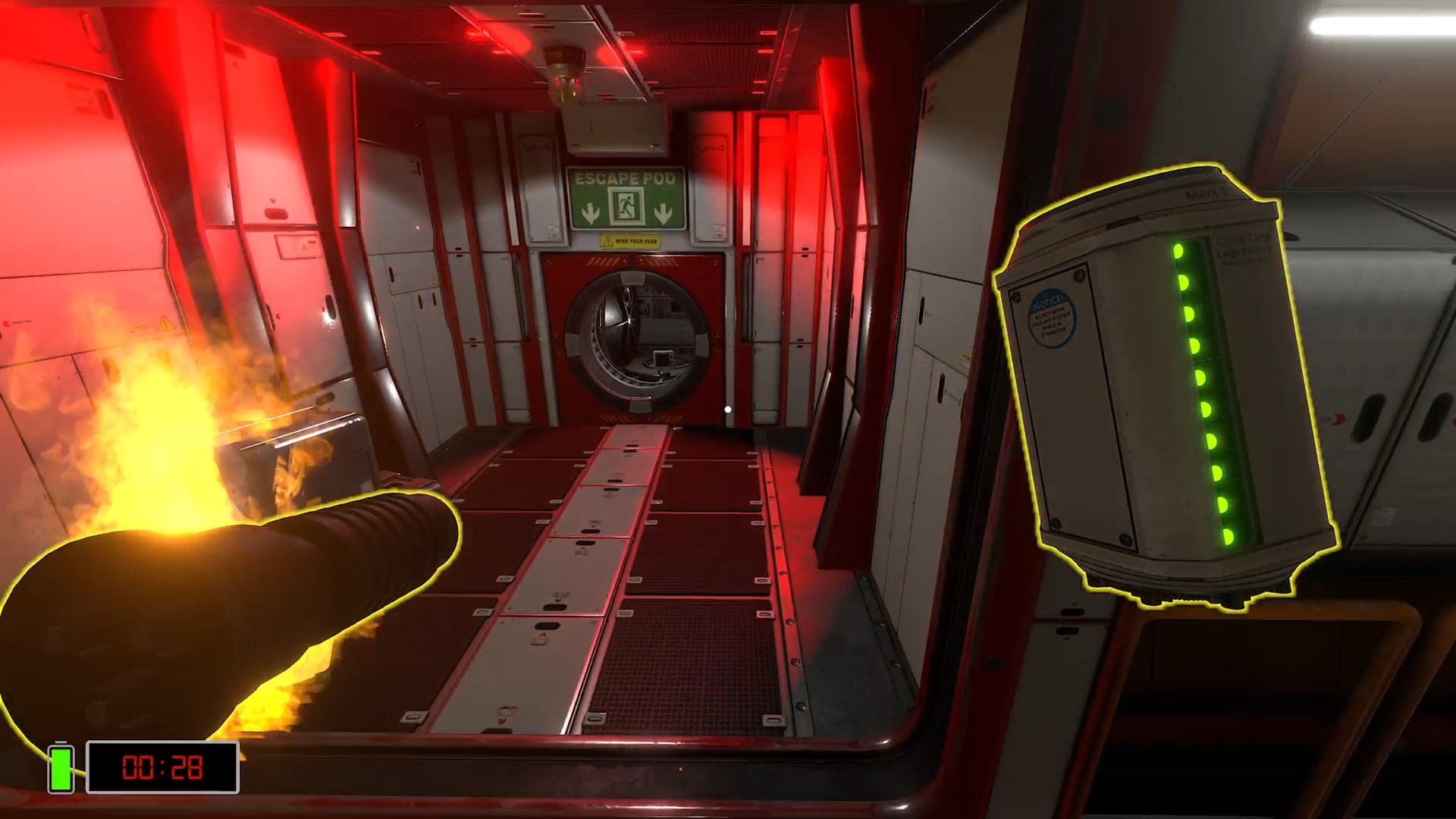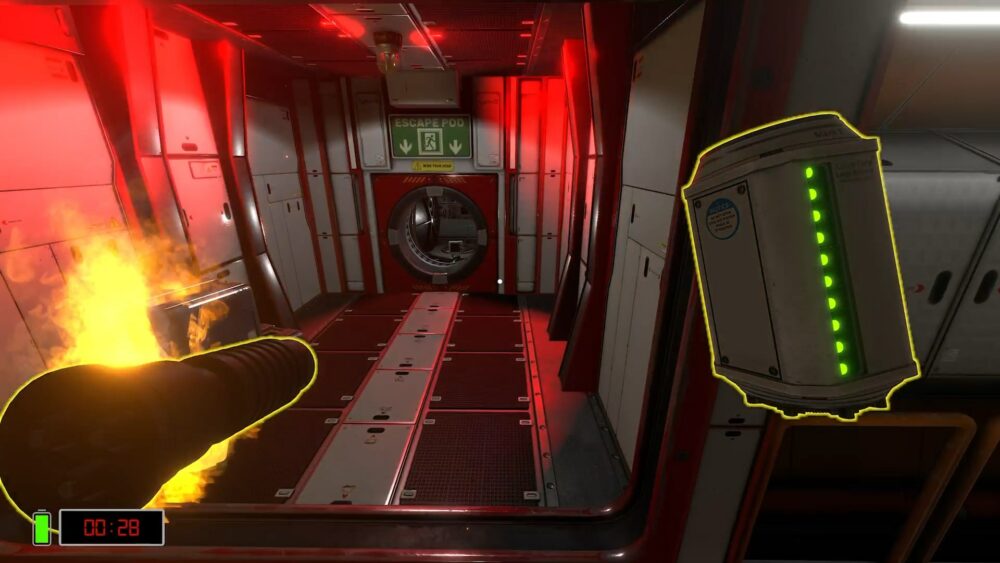
I think my worst fear would be having to use an escape pod due to a malfunction in my spaceship. Or perhaps it would be going face-to-face with an acid-breathing alien trying to eat me. In films, those ships always look like sanctuaries from oncoming disaster; a haven that will transport you away from danger, onto a welcoming planet or friendly space transport.
But what happens if the escape pod you are in is trying to kill you, falling apart around your ears? Have you got the know-how to try and keep the thing afloat in space? Well, that’s what Tin Can offers as a game – it puts you in the worst-designed escape pod ever and sees how long you can keep alive. As you can tell from my musings, I’m still stressed from the experience.
Tin Can gets high marks for making a highly original game; something that is pretty unique and unusual. The game puts you in the role of a cleaner on a space station that has seen better days. In the engaging tutorial, you are sent from the command into the escape pod to make sure the systems are working correctly. You get an idea that this ship is having problems with its reactor from the voice-over. But then when the game starts there is a massive fire onboard and you have to get into the escape pod and try to survive as long as you can. But how do you do this?
Playing out in the first person, mostly you will be found in the aforementioned Tin Can escape pod. In the beginning, you are outside the pod, left to furiously gather as many resources as possible, hoping they will help you later. But as things start to go wrong, it becomes up to you to identify the problems and try to stop them before you die.
On the most simplest of levels, the Tin Can will spring a leak, a hole letting out precious oxygen. To fix it you will need to grab a sealing canister which you spray on, filling the hole shut. Then on the other end, you will have to examine the maintenance handbook after reading a computer error code, relating that code to the problem in the manual and then trying to fix the problem. This might be a faulty canister that you need to make from scratch by decommissioning other parts. It’s very complex and precise, but also very clever. Secretly, it’s a little bit addictive.
There isn’t a campaign to speak of in Tin Can, but rather random times in where you try and last as long as you can, comparing to online leaderboards. But while in the Tin Can all sorts of problems will be thrown at you, like fuses popping, asteroids hitting or a electric space storm playing out. You have to work through all these problems methodically and carefully but also with a sense of urgency. It’s a game where you only play through in short sections (mostly because you die), but also there isn’t a real story to get your teeth into.
Visually the game does a good job with all the parts, systems, and tools shown on an imaginary space pod. It feels tight and claustrophobic, but never messy visually. The attention to detail, from the manual handbook to the wiring of a computer system, seems well designed and looks great. Sound-wise it delivers some decent effects and a good voice-over in the tutorial section.
If you’re a fan of design, engineering, or sim games, then you should have a lot of fun with Tin Can. The lack of a campaign or story may affect matters, but the methodical workings as you tackle problems feels brilliant; an original piece of addictive gameplay.
What you’ll mostly learn from Tin Can though, is that heading into space may not be as enjoyable as you first thought.
- SEO Powered Content & PR Distribution. Get Amplified Today.
- PlatoAiStream. Web3 Data Intelligence. Knowledge Amplified. Access Here.
- Minting the Future w Adryenn Ashley. Access Here.
- Buy and Sell Shares in PRE-IPO Companies with PREIPO®. Access Here.
- Source: https://www.thexboxhub.com/tin-can-review/
- 1
- a
- affect
- aforementioned
- after
- AI
- alien
- All
- also
- always
- an
- and
- ARE
- around
- as
- asteroids
- At
- attention
- away
- BE
- because
- before
- beginning
- Better
- Bit
- but
- by
- Campaign
- CAN
- carefully
- code
- comparing
- complex
- computer
- content
- correctly
- Danger
- days
- Design
- designed
- detail
- disaster
- do
- does
- due
- eat
- effects
- Electric
- end
- engaging
- Engineering
- escape
- EVER
- examine
- experience
- Fear
- films
- Fire
- First
- Fix
- For
- friendly
- from
- fun
- game
- gameplay
- Games
- gather
- Get
- go
- going
- good
- grab
- great
- happens
- has
- Have
- having
- heading
- help
- High
- highly
- hitting
- hole
- hoping
- How
- HTTPS
- idea
- identify
- if
- in
- into
- Is
- IT
- ITS
- Job
- jpg
- keep
- lack
- last
- later
- leak
- LEARN
- left
- levels
- like
- Little
- Long
- Look
- looks
- lot
- maintenance
- make
- Making
- manual
- many
- massive
- Matters
- May
- methodical
- might
- most
- mostly
- need
- never
- not
- of
- Offers
- on
- onboard
- online
- only
- or
- original
- Other
- out
- Oxygen
- planet
- plato
- plato data intelligence
- platodata
- platogaming
- play
- Playing
- possible
- precious
- precise
- pretty
- Problem
- problems
- rather
- Reading
- Real
- Resources
- review
- role
- section
- seems
- seen
- sees
- sense
- Sense of Urgency
- ships
- Short
- should
- shown
- SIM
- some
- something
- Space
- space station
- speak
- spring
- start
- station
- still
- Storm
- Story
- survive
- system
- Systems
- tell
- that
- The
- The Game
- Them
- then
- there
- These
- they
- thing
- things
- think
- this
- those
- though
- thought
- Through
- times
- to
- tools
- transport
- tutorial
- unique
- unusual
- up
- use
- very
- welcoming
- well
- What
- when
- where
- while
- will
- with
- Work
- working
- worst
- would
- wrong
- you
- your
- zephyrnet












